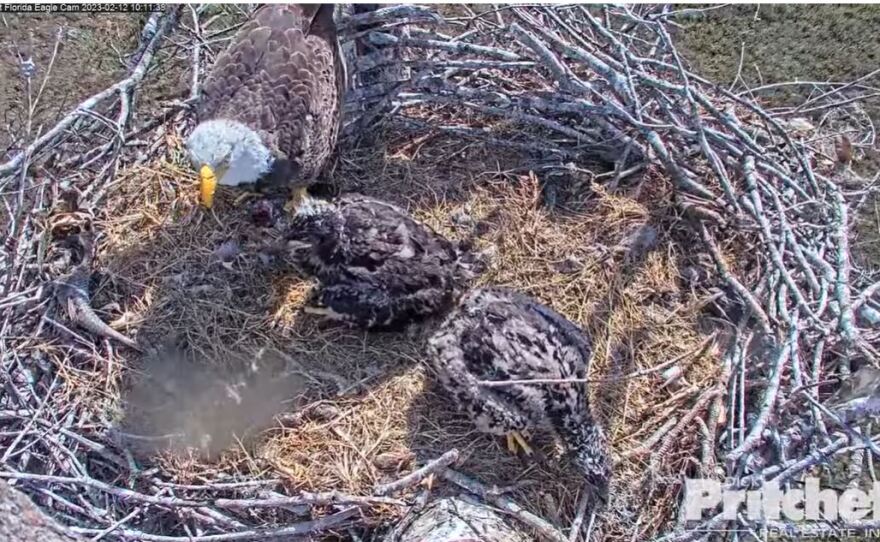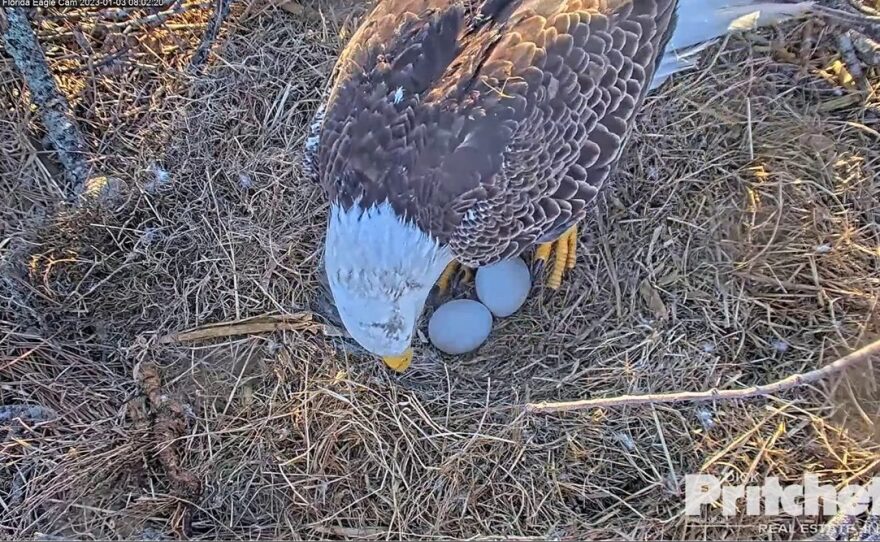Despite nest destruction from Hurricane Ian, resilience proved to be the theme of the 2022-23 bald eagle nesting season, according to end-of-season data compiled by the Audubon EagleWatch program.
A new report from Audubon Florida said that in the aftermath of the Category 5 Hurricane Ian in late September, EagleWatch volunteers returned to monitoring bald eagle nests as soon as possible, even as they faced significant damage to their own homes and communities. Across the state, volunteers documented 148 nests lost to the storm.
Typically, when an eagle pair loses a nest, they simply rebuild in another suitable tree nearby. In the storm’s path, however, suitable trees were also lost. With few other options, many eagle pairs rebuilt their nests in spindly trees with bare branches and little foliage. According to EagleWatch data, roughly 70 percent of the eagle pairs that lost their nests rebuilt in the same season.
From those rebuilt nests, more than 100 chicks have fledged.
Those numbers include Southwest Florida's own Harriet and M15 and their two fledglings, E21 and E22. The North Fort Myers eagles also saw significant nest damage but managed to repair it before Harriet laid the two eggs in late November.
Tragedy did strike the pair when Harriet went missing in early February. She was never found.
The male, M15, diligently raised the chicks and saw them both fledge the nest by June 10.
“The resilience of our eagles always inspires me," says Shawnlei Breeding, EagleWatch Program Manager. "No matter what challenges they face, they carry on. Their tenacity serves them well in Florida’s ever-changing landscape. EagleWatch data helps document how eagles respond to these changes and guide management practices to ensure that they continue to thrive."

The Audubon EagleWatch program began in 1992 with 22 volunteers monitoring nests in three Central Florida counties with the goal of documenting nests and protecting them from disturbance so that future generations of Floridians might enjoy seeing this amazing raptor. At that time, Bald Eagles were still on the federal list of Threatened and Endangered Species.
Harriet and M15, SWFL Eagle saga
North Fort Myers eagles Harriet, M15 now incubating two eggs
Second eaglet hatches; Harriett and M15 get down to the business of raising a family of eagles
WHERE'S HARRIET? Mom eagle missing from nest for days; Dad M15 defends, feeds eaglets
Harriet still missing; M15 feeding the eaglets, defending nest
Delivery services reportedly being used to bring food to Harriet and M15's North Fort Myers nest
What will happen without Harriet? SWFL Eagle Cam gives nest update
A SWFL Eagle Cam season to remember — might it be the last?
With protections, Florida’s population of Bald Eagles grew from less than 100 nesting pairs in the 1970s to 600 by 1992, but the species still faced multiple threats and pressures in Florida from the rapidly growing human population. Fast forward 30 years and the program has grown to more than 600 volunteers monitoring 1100+ nests in 53 counties.

Thanks to continued legal protections and the monitoring efforts of the EagleWatch Program over the past three decades, Florida’s eagle population has made an amazing recovery and is now considered stable, with approximately 2,500 nesting pairs.
Today, volunteers collect important data including active nest locations, eaglets, and possible disturbances or threats to nesting activity. In addition to hurricanes, Bald Eagles in Florida face many other challenges, including rodenticide poisoning, vehicle strikes, and habitat loss. Through monitoring, volunteers protect nests from illegal disturbances and rescue eaglets that have fallen from nests, giving them a second chance at life.
Audubon EagleWatch is based at the Audubon Center for Birds of Prey in Maitland, FL. The Center treats more than 700 raptors each year, including eagles, hawks, and owls. Those that survive are either released where they were found or placed at zoos and other properly licensed facilities nationwide.
Visitors can see Florida’s native raptors up close at the Center for Birds of Prey in Maitland: visit Tuesday – Sunday between 10 a.m. and 4 p.m.
Audubon Florida provided the information for this report. WGCU is your trusted source for news and information in Southwest Florida. We are a nonprofit public service, and your support is more critical than ever. Keep public media strong and donate now. Thank you.





















